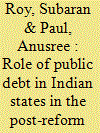|
|
|
Sort Order |
|
|
|
Items / Page
|
|
|
|
|
|
|
| Srl | Item |
| 1 |
ID:
193052


|
|
|
|
|
| Summary/Abstract |
Empirical investigation finds that firm-specific factors, namely deleveraging of balance sheets, comfortable cash flows and improving debt servicing capacity impact fixed investment in private corporate sector positively. Monetary policy impacts fixed assets investment growth of financially constrained firms more compared to non-financially constrained firms. Furthermore, the impact of COVID pandemic on investment was more adverse in case of weak firms.
|
|
|
|
|
|
|
|
|
|
|
|
|
|
|
|
| 2 |
ID:
193050


|
|
|
|
|
| Summary/Abstract |
The idea that regional integration is the podium of economic growth dates back a long time. Even now, a plethora of literature confirms a strong and positive link between regional integration and economic growth. However, most of these studies are focused on developed countries. Indeed, literature from developing countries is scant, and that from underdeveloped and landlocked countries like Afghanistan is almost non-existent. In the context of South Asian Free Trade Agreement, this article endeavours to innovatively scrutinize the trends in exports, imports and trade at different industry levels in the trade specialization of Afghanistan. At the harmonized standard 6-digit level of product classification, the study has employed the Lafay Index approach. The study finds that Afghanistan has a greater affinity for resource-intensive manufacturing products and non-fuel primary commodities. The study suggests that Afghanistan should confront issues such as its trade deficit, its dependency on agricultural products for export and the underutilization of its natural resources. The results show that Afghanistan still has a competitive disadvantage over South Asian Association for Regional Cooperation (SAARC) members at different industry levels. The study recommends dealing with problems including technology diffusion, product diversity and quality sophistication at various industrial levels, which restrict a higher degree of trade specialization.
|
|
|
|
|
|
|
|
|
|
|
|
|
|
|
|
| 3 |
ID:
193049


|
|
|
|
|
| Summary/Abstract |
Using the data from 1991 to 2019, this study attempts to verify Okun’s law by utilizing both ‘The difference and the dynamic versions’ of Okun’s law in Bangladesh and tries to find the value of Okun’s coefficient. The autoregressive-distribution lag (ARDL) bounds test is applied to determine the existence of a long-term relationship between the variables, and then the ordinary least squares (OLS) approach is used to estimate the findings. The findings show that Okun’s coefficient is –0.058 for the difference version of Okun’s law, which is statistically insignificant. In addition, for the dynamic version of Okun’s law, findings show that the effect of the ‘immediate past economic growth rate’ on ‘current change in the unemployment rate’ is 0.15, and it is statistically insignificant too. However, the effect of the ‘current economic growth rate’ on ‘current change in the unemployment rate’ is –0.22, and it is statistically significant at 10% significance level. In both versions of Okun’s law, R2 values, F-statistic and cumulative sum of squares show the instability of the models. Due to statistically insignificant coefficients and model instability, it can be concluded that Okun’s law is invalid in Bangladesh.
|
|
|
|
|
|
|
|
|
|
|
|
|
|
|
|
| 4 |
ID:
193048


|
|
|
|
|
| Summary/Abstract |
This study evaluates the financial and social efficiency of Indian Microfinance Institutions (MFIs) from 2005 to 2018 and also tries to find out the determinants of financial and social efficiency. In the first step, bias-corrected bootstrap Data Envelopment Analysis (DEA) efficiency scores for financial and social efficiency were calculated using two input and two output variables. In the second step of analysis above efficiency scores have been used as dependent variables and Seemingly Unrelated Regression (SUR) model is employed to ascertain the determinants of financial and social efficiency of Indian MFIs. The study finds that the aggregate financial efficiency of Indian MFIs is higher than the social efficiency. Over the study period, efficiency of Indian MFIs shows an increasing trend. Results of SUR suggest that as compared to Non-Banking Finance Company (NBFC) MFIs, Non-NBFC MFIs’ financial and social efficiency is better. Influence of age, scale of loan portfolio, asset quality and financial leverage on efficiency of MFIs are insignificant. This study also finds that asset size of the firm is positively associated with efficiency. Evidence from this study suggests that reform measures taken post microfinance crises has negatively affected the financial efficiency. However, social efficiency has improved during post reform period.
|
|
|
|
|
|
|
|
|
|
|
|
|
|
|
|
| 5 |
ID:
193051


|
|
|
|
|
| Summary/Abstract |
The substantial amount of existing literature investigating the debt–growth association for high-income countries shows that debt has a negative impact on economic growth or the existence of an inverted U-shaped relationship between these two variables on some occasions. Given the lack of literature involving developing economies in this space, our study entirely focuses on a developing country like India. The study examines the empirical relationship between public debt (internal) and state gross domestic product (SGDP) for India in the post-reform era. The panel data extend from the year 2000 till 2020. Our random error component model findings indicate a positive and significant impact of debt in enhancing the Indian SGDPs for the above-mentioned period. Results are also confirmed by using an alternative estimation technique, namely, fixed effect. Next, we address the issue of endogeneity by employing generalized method of moments. Our results continue to remain robust. Finally, the inclusion of other control variables does not alter our findings.
|
|
|
|
|
|
|
|
|
|
|
|
|
|
|
|
| 6 |
ID:
193053


|
|
|
|
|
| Summary/Abstract |
This study investigates into intergenerational occupational mobility of Indian workers towards and within service sectors during globalization. In particular, such mobility of workers is observed in the presence of structural shift of the economy towards service industry, especially towards service trade, and explores whether there is intergenerational mobility towards services and more skill-oriented occupations in India during 1999–2011. The Altham measure of relative mobility is applied on the National Sample Survey Organization employment–unemployment survey database to measure the degree of association between occupational choice of fathers and co-resident sons in urban India. An upward mobility among sons is observed between 1999–2000 and 2011–2012.
|
|
|
|
|
|
|
|
|
|
|
|
|
|
|
|
|
|
|
|
|